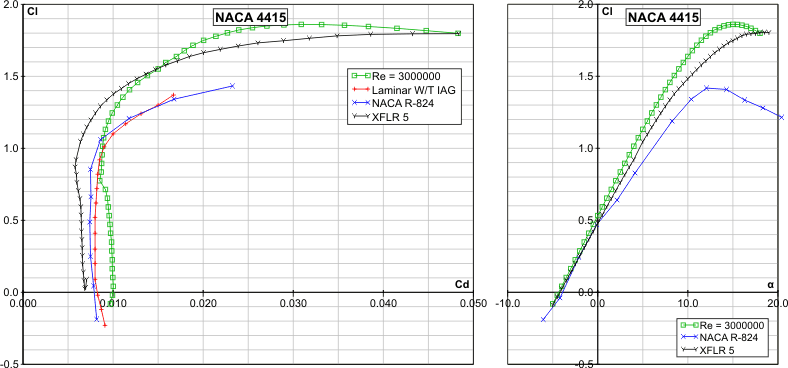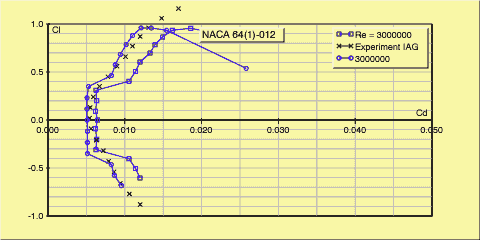
Validation and Accuracy |
Like all mathematical models, the procedures combined in JavaFoil can only approximate real physics. Thus deviations between experiments and JavaFoil results can be expected and the results should be used with thought. It is always a good idea to perform some tests of your own before you start complex development work with a computer program like JavaFoil or the like.
Some comparisons between Experiments at the laminar wind tunnel of the Institute of Aero- and Gas-Dynamics of the University of Stuttgart are shown below.
This classic airfoil has been analyzed with JavaFoil and compared against wind tunnel tests performed in the Laminar Wind Tunnel at Stuttgart, The data presented in NACA Report No. 824 and results produced by XFLR5, an implementation of the XFOIL algorithms. The airfoil coordinates were created with JavaFoil, using the standard number of 61 points.
The maximum lift coefficient is over-predicted by both numerical methods (JavaFoil, XFLR5). The lift gradient is (dCl/dalfa) is also overpredicted because no boundary layer displacement effects are modeled. While these are modeled in XFLR5, the deviation from the experimental values is also rather large. The drag coefficient lies close to the experimental values but is considerably higher than the XFLR5 prediction. At lower lift coefficients, the lower surface becomes fully turbulent and the drag is predicted too high.

Here we see a similar result with the analysis quite close to the experimental data. The airfoil coordinates were created with JavaFoil, using the standard number of 61 points.

The coordinates for this airfoil were imported from the Wiechers/Bender coordinate database and the analysis was performed for two cases, using a smooth surface. The first analysis used the given 51 points, which were defined near the trailing edge at 90%, 95% and 100%. This created the first curve with higher drag coefficients. Then the coordinates were re-splined to only 53 points using the Modify card of JavaFoil. This created a "cosine spaced" coordinate set with a finer resolution at the trailing edge. The analysis shows a closer agreement with the experiments, but maximum lift is under predicted.

This example shows, that you should use enough points (at least 50, better 80 to 120) and that the points must be distributed more dense in regions where the velocity distribution shows large gradients. This is usually the case close to the leading and trailing edges.
Last modification of this page: 21.05.18
![]()
[Back to Home Page] Suggestions? Corrections? Remarks? e-mail: Martin Hepperle.
Due to the increasing amount of SPAM mail, I have to change this e-Mail address regularly. You will always find the latest version in the footer of all my pages.
It might take some time until you receive an answer
and in some cases you may even receive no answer at all. I apologize for this, but
my spare time is limited. If you have not lost patience, you might want to send
me a copy of your e-mail after a month or so.
This is a privately owned, non-profit page of purely educational purpose.
Any statements may be incorrect and unsuitable for practical usage. I cannot take
any responsibility for actions you perform based on data, assumptions, calculations
etc. taken from this web page.
© 1996-2018 Martin Hepperle
You may use the data given in this document for your personal use. If you use this
document for a publication, you have to cite the source. A publication of a recompilation
of the given material is not allowed, if the resulting product is sold for more
than the production costs.
This document may accidentally refer to trade names and trademarks, which are owned by national or international companies, but which are unknown by me. Their rights are fully recognized and these companies are kindly asked to inform me if they do not wish their names to be used at all or to be used in a different way.
This document is part of a frame set and can be found by navigating from the entry point at the Web site http://www.MH-AeroTools.de/.